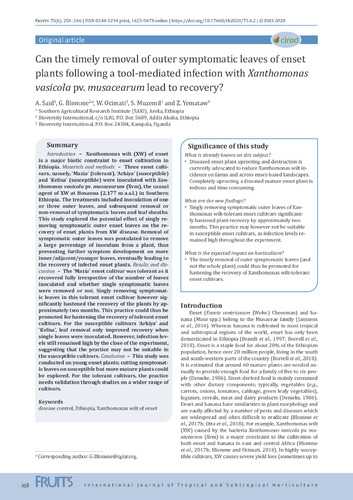Can the timely removal of outer symptomatic leaves of enset plants following a tool-mediated infection with Xanthomonas vasicola pv. musacearum lead to recovery?
Xanthomonas wilt (XW) of enset is a major biotic constraint to enset cultivation in Ethiopia. Three enset cultivars, namely, ‘Mazia’ (tolerant), ‘Arkiya’ (susceptible) and ‘Kelisa’ (susceptible) were inoculated with Xanthomonas vasicola pv. musacearum (Xvm), the causal agent of XW at Hosanna (2,177 m a.s.l.) in Southern Ethiopia. The treatments included inoculation of one or three outer leaves, and subsequent removal or non-removal of symptomatic leaves and leaf sheaths. This study explored the potential effect of singly removing symptomatic outer enset leaves on the recovery of enset plants from XW disease. Removal of symptomatic outer leaves was postulated to remove a large percentage of inoculum from a plant, thus preventing further symptom development on more inner/adjacent/younger leaves, eventually leading to the recovery of infected enset plants. The ‘Mazia’ enset cultivar was tolerant as it recovered fully irrespective of the number of leaves inoculated and whether single symptomatic leaves were removed or not. Singly removing symptomatic leaves in this tolerant enset cultivar however significantly hastened the recovery of the plants by approximately two months. This practice could thus be promoted for hastening the recovery of tolerant enset cultivars. For the susceptible cultivars ‘Arkiya’ and ‘Kelisa’, leaf removal only improved recovery when single leaves were inoculated. However, infection levels still remained high by the close of the experiment, suggesting that the practice may not be suitable in the susceptible cultivars. This study was conducted on young enset plants; cutting symptomatic leaves on susceptible but more mature plants could be explored. For the tolerant cultivars, the practice needs validation through studies on a wider range of cultivars.

